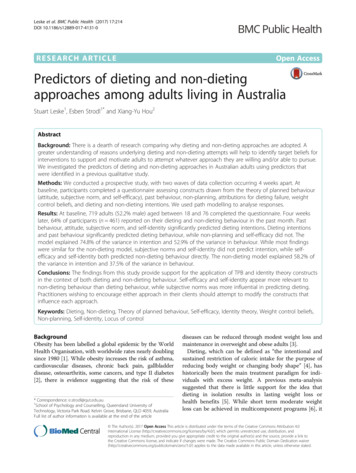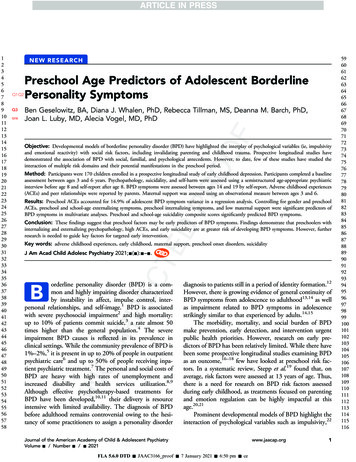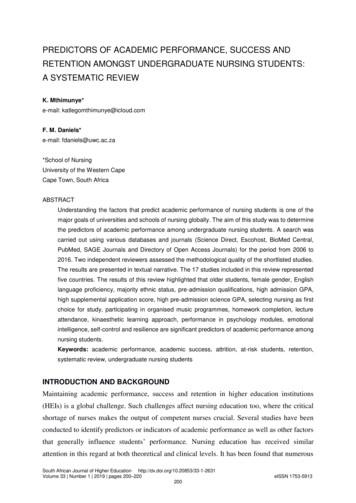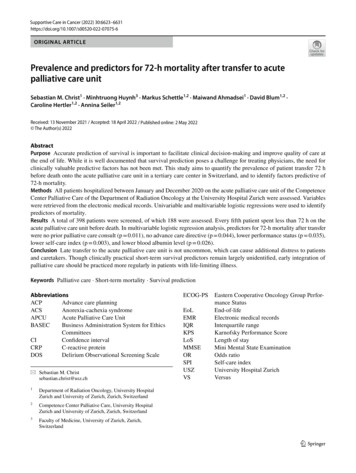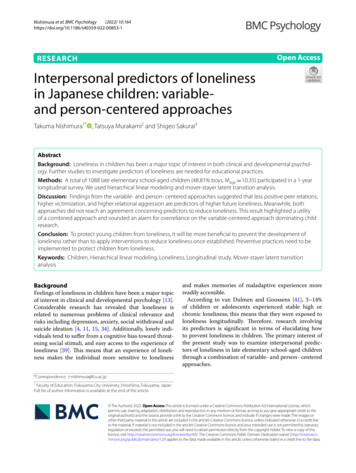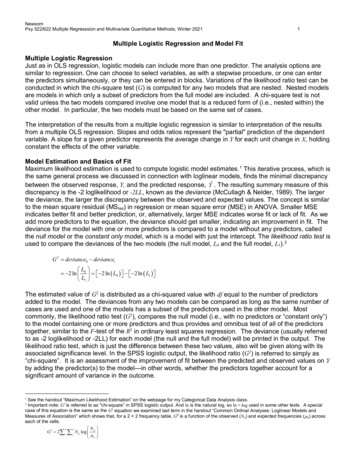
Transcription
POTENTIAL PREDICTORS OF ADEQUATE KNOWLEDGE OF FIRST AIDPRINCIPLES AMONG TEXAS HIGH SCHOOL COACHESTHESISPresented to the Graduate Councilof Texas State University-San Marcosin Partial Fulfillmentof the Requirementsfor the DegreeMasters of EDUCATIONbyCynthia J. Wright, B.A.San Marcos, TexasDecember 2006
POTENTIAL PREDICTORS OF ADEQUATE KNOWLEDGE OF FIRST AIDPRINCIPLES AMONG TEXAS HIGH SCHOOL COACHESCommittee Members Approved:Dr. John Walker, ChairDr. Jack RansoneDr. Robert PankeyApproved:J. Michael WilloughbyDean of the Graduate College
COPYRIGHTbyCynthia J. Wright, B.A.2006
ACKNOWLEDGEMENTSI would like to begin by thanking my parents for their strong support throughoutmy entire undergraduate and now graduate studies. Without my family’s encouragementand love I could not have weathered the rough times that precede any goal worthachieving.There have been many educators whose teaching over the years has led me to thispoint. Specifically I want to thank Daman, without whose preparation in research Iwould have been lost. I am also very thankful to the members of my thesis committee.Each has willingly spent many extra hours guiding me to the final draft you now read.This manuscript was submitted on November 15, 2006.iv
TABLE OF CONTENTSPageACKNOWLEDGEMENTS.ivLIST OF TABLES. viLIST OF FIGURES . viiABSTRACT . viiiCHAPTERI. INTRODUCTION TO THE STUDY.1II. LITERATURE REVIEW .7III. METHODS .32IV. RESULTS.36V. DISCUSSION.44APPENDIX .49REFERENCES .57v
LIST OF TABLESTablePage1. Reportable Injuries, Injured Players, and Injury Rates forSelected High School Sports.132. Percentages of Reported Injuries by Body Category forSelected HS Sports.143. Percentage of Reported Injuries by Type of Injury.154. Selected Participant Demographics.375. Relationship of FAA Scores & Years Experience toDemographic Variables.38vi
LIST OF FIGURESFigurePage1. Correlation of FAA scores to time since taking a C&P course .412. Correlation between FAA score and experience.42vii
ABSTRACTPOTENTIAL PREDICTORS OF ADEQUATE KNOWLEDGE OF FIRST AIDPRINCIPLES AMONG TEXAS HIGH SCHOOL COACHESbyCynthia J. Wright, B.A.Texas State University-San MarcosDecember 2006SUPERVISING PROFESSOR: JOHN WALKERThe purpose of this study was to identify potential predictors of adequateknowledge of first aid principles applied to the athletic setting among Texas high school(HS) coaches. Participants were 169 HS coaches near Austin, Texas, who participated byfilling out a demographic questionnaire and a 27-item First Aid Assessment (FAA) whichassessing both first aid and CPR knowledge. Data were analyzed for correlation or groupdifferences between FAA score and demographic data. ANOVA, χ2, and regressionanalysis were performed on the data using Statview 5.0.viii
A significant difference in FAA score was observed between respondents whohad taken a course in Care & Prevention course and those who had not. A significantpositive correlation existed between years of experience and FAA score (R .23, p .002). However, there was no significant relationship between FAA score andcertification in first aid, certification in CPR or undergraduate major. The results of thestudy indicate that years of experience are the most important factor in predictingcoaches’ knowledge of first aid principles.Coaches’ overall knowledge of first aid principles was found to be insufficient toadequately safeguard the health of high school athletes, with 30.2% of coaches failing theFAA (score 70%). Results emphasize the importance of employing professionallytrained personnel to provide athlete health care. Future research should establish exactlywhat knowledge is essential for coaches, and investigate alternative training models thatmore effectively equip coaches with the knowledge needed to act prudently regardingathletic injury or illness.ix
CHAPTER 1INTRODUCTION TO THE STUDYApproximately 7 million high school (HS) students engaged in school sponsoredathletic programs in the 2004-2005 academic year (National Federation of State HighSchool Associations, 2005). Currently it is estimated that from 1 in 2 to 1 in 5 studentathletes will sustain a sports related injury (Aukerman, Aukerman, & Browning, 2006;Carek, Dunn, & Hawkins, 1999; Lyznicki, Riggs, & Champion, 1999) and in rare cases,1 in 100,000 HS athletes, will suffer a catastrophic injury resulting in severe injury,paralysis or even death (Andersen, Courson, Kleiner, & McLoda, 2002; Lyznicki et al.,1999).Over half of all injuries occur during practice (Powell & Barber-Foss, 1999)where the coach is least likely to have the supporting presence of a team physician orcertified athletic trainer (Bell, Prendergast, Schlichting, Mackey, & Mackey, 2005;Lindaman, 1991; Rutherford, Niedfeldt, & Young, 1999; Tonino & Bollier, 2004). In theabsence of other qualified healthcare providers, the coach most often assumes theresponsibility for providing initial healthcare and making decisions regarding athletes’return to play (Hage & Moore, 1981; Koabel, 1995; Stapleton et al., 1984). In commonminor injury situations like sprains, strains and contusions, proper initial care canminimize the extent of injury and prevent excess pain, loss of playing time and possible1
2future complications (Booher & Thibodeau, 2000; Prentice & Arnheim, 2003; Starkey &Ryan, 2002). In a life-threatening situation, early recognition of the emergency and earlyCPR can greatly increase the chance of survival (Terry et al., 2001). However, previousresearch has shown that coaches are under-qualified to make such healthcare decisions,and are influenced in their decision making by game score and athletes’ ability level(Flint & Weiss, 1992; Lyznicki et al., 1999; Ransone & Dunn-Bennett, 1999; Rowe &Miller, 1991), creating an unreasonable risk of negative outcomes for the injured HSstudent-athlete.To protect athlete safety, several athletic organizations advocate mandatorycertification in CPR and first aid for all coaches (Andersen et al., 2002; Shores, 2001);however implementation of their recommendations is sporatic with each state or evendistrict adopting its own policy (State of Texas, 2003; Vangsness et al., 1994).Additionally some research indicates that even mandatory certification may not besufficient (Ransone & Dunn-Bennett, 1999; Vangsness, Hunt, Uram, & Kerian, 1994).Although California requires all paid coaches to maintain current CPR and first aidcertification (Vangsness et al., 1994) only 36% passed the First Aid Assessmentadministered by Ransone and Dunn-Bennett (1999). Rowe and Robertson (1986) foundsimilar knowledge deficits, with only 27% of coaches meeting the criteria level foroverall knowledge in all six of their categories.Previous research has failed to thoroughly evaluate the knowledge level of highschool coaches regarding athletic injury, and in particular to determine the influence ofcertification or educational background on such knowledge. Furthermore, there is a needto determine potential predictors of adequate knowledge of athletic injuries and proper
3treatment among coaches. Only through thorough evaluation can appropriaterecommendations for the minimum level of training required of coaches be made.Purpose of the StudyThe purpose of this study is to identify potential predictors of adequate knowledgeof first aid principles applied to the athletic setting among Texas high school coaches.This will be accomplished by determining the relationship between knowledge level (asassessed by the First Aid Assessment), the coach’s formal educational background(including college major, certifications held, and continuing education classes taken), andthe time (in months) since the most recent training in care and prevention of athleticinjuries, CPR, and first aid has taken place.HypothesesIt is hypothesized that coaches with CPR and first aid training who’ve also taken acourse in care and prevention of athletic injury will perform better on the First AidAssessment than coaches with CPR and first aid training alone.It is hypothesized that performance on the First Aid Assessment will have aninverse relationship with the number of months since the coach last completed a course inathletic injury care and prevention.It is hypothesized that coaches with a degree in physical education, exercisescience, or related field will score significantly higher on the knowledge assessments thancoaches with a degree in another field.Operational Definitions1. Athletic trainer versus certified athletic trainer (ATC)—In the early years of theathletic training profession the title “athletic trainer” was often bestowed on any
4person who worked with athletic injuries, regardless of training. Nationalcertification (ATC) and state licensure (LAT) have since restricted the title ofathletic trainer to persons meeting specific standards and requirements. In thisproposal the term athletic trainer will be used in connection with study data thatdid not specify if the athletic trainer was certified or not, whereas ATC will beused only for Board of Certification nationally certified athletic trainers.2. Return to play—the point in time when an injured athlete is medically released toreturn to activity post-injury; the point where it is determine that the chance of reinjury is minimal and is an acceptable risk of participationDelimitationsThis study is delimited to high school coaches in Texas within a 1.5 hours radiusof Austin, Texas.This study is delimited by Texas Education Code 33.086, which states that “Aschool district employee who serves as the head director of a school marching band or asthe head coach or chief sponsor for an extracurricular athletic activity, includingcheerleading, sponsored or sanctioned by a school district or the UniversityInterscholastic League must maintain and submit to the district proof of currentcertification in first aid and cardiopulmonary,” (State of Texas, 2003).This study is delimited by the Constitution and Contest Rules of the UniversityInterscholastic League (UIL), the governing body of athletics in Texas public schools.UIL policy requires that coaches be full-time employees of the district. However,interpretation 29 of this policy makes allowances so that minimum of 15 hours a week isacceptable in specific circumstances (UIL, 2006).
5LimitationsThis study was limited to participants in central Texas. Therefore, while theresults are representative of the central Texas region, caution should be using ingeneralizing findings to other states or the United States as a whole.The results of this study were limited by Texas Education Code 33.086, whichstates requires all head coaches to maintain current CPR and first aid certification.Because of this limitation the percentage of coaches that possess these certifications inTexas may be higher than in other states without similar mandates, and this may haveinfluenced the findings of the study. Caution should be used when making interstatecomparisons.The participants in this study were limited to high school coaches. Cautionshould be taken in generalizing the results of this to middle school coaches.Significance of the StudyWith approximately 56% of American high school students participating in 1 ormore sports teams each year (Center for Disease Control, 2006), the handling of athleticinjuries and emergency situations affects a large segment of the population, includingparents, athletes, coaches, medical professionals and administrators. The state of Texas,which has the greatest number of high school athletes of any state in the country, requiresfirst aid and CPR certification as the minimum level of training for all head coaches butdoes not specify the amount of training required of assistant coaches (Texas EducationCode 33.086). This study will evaluate whether CPR and first aid certification is areliable predictor of adequate knowledge of first aid principles among Texas high schoolcoaches. Results could validate Texas law mandating certification of head coaches as the
6minimum level of medical training necessary; and encourage the broadening of thestatute to apply to all athletic coaches.In addition this study will track other variables such as college major, years ofexperience, and completion of a course in care and prevention of athletic injuries, in orderto determine the variable or combination of variables that most validly predict thegreatest level of competence among high school coaches.
CHAPTER 2LITERATURE REVIEWYouth sports participation, specifically at the high school (HS) level has increasedenormously in the last several decades (Aukerman, Aukerman, & Browning, 2006; Terryet al., 2001) and there are now approximately seven million HS athletes in America(National Federation of State High School Associations, 2005). In 2005, 56.0% of all HSstudents played on one or more sports teams (Center for Disease Control, 2006).Growing numbers of athletes participating in increasingly competitive sport activitiesgreatly increases the likelihood of athletic injuries. Currently it is estimated that from 1in 2 to 1 in 5 student-athletes will sustain a sports related injury (Aukerman et al., 2006;Carek, Dunn, & Hawkins, 1999; Lyznicki, Riggs, & Champion, 1999) and in rare cases,1 in 100,000 HS athletes, will suffer a catastrophic injury resulting in severe injury,paralysis or even death (Andersen, Courson, Kleiner, & McLoda, 2002; Lyznicki et al.,1999).Due to the increased overall number of injuries, the increased chance of injury,and the litigious nature of society, concerns about the immediate medical care availablefor HS athletes have been raised by parents, healthcare professionals, coaches andadministrators alike (Hage & Moore, 1981; Lindaman, 1999; Rowe & Miller, 1991;7
8Shores, 2001; Tonino & Bollier, 2004). In common minor injury situations like sprains,strains and contusions proper initial care can minimize the extent of injury and preventexcess pain, loss of time and future complications (Booher & Thibodeau, 2000; Prentice& Arnheim, 2003; Starkey & Ryan, 2002). In a life-threatening situation earlyrecognition of the emergency and early CPR can greatly increase the chance of survival(Terry et al., 2001).HS athletic coaches frequently assume responsibility for providing initial injurycare to their athletes and make decisions whether an injured athlete can return to play ornot (Koabel, 1995; Rowe & Miller, 1991; Stapleton, Tomlinson, Shepard, & Coon, 1984;Stout, 1997). However, research has shown that coaches are under-qualified to makesuch healthcare decisions, and are influenced in their decision making by game score andathlete ability level (Flint & Weiss, 1992; Lyznicki et al., 1999; Ransone & DunnBennet, 1999; Rowe & Miller, 1991) creating an unreasonable risk of negative outcomesfor the HS student-athlete. The National Athletic Trainer’s Association (NATA) positionstatement on emergency planning states that, “Sports medicine professionals, officialsand coaches should be trained in automatic external defibrillation, CPR, first aid, andprevention of disease transmission” (Andersen et al., 2002). Yet, coaches consistentlyfail to meet even this basic standard (Carek et al., 1999; Furney, 1987; Stapleton et al.,1984; Tonino & Bollier, 2004). To better understand the challenges presented to thesafety and wellbeing of student-athletes this review of the relevant research literature willfocus on injuries in HS athletics, personnel treating HS student athletes, coach’s trainingand concerns with coaches acting as healthcare providers.
9Injury in High School AthleticsOf the 55.1% of American HS students participating in one or more sports teams,37.7% sought medical treatment as a result of participation (Aukerman et al., 2006). Thisleads to an overall injury rate of 1 in 3, however studies that focus primarily on footballinjuries have reported rates as high as 1 in 2 whereas controlling for football injuryreduces the rate to 1 in 5 (Lyznicki et al., 1999; Powell & Barber-Foss, 1999). If themost conservative estimate is used, 1/5 of the 7 million HS athletes calculates as 1.4million athletic injuries a year in HS alone. However, the National Federation of StateHigh School Associations survey of athletic participation reported 2 million injuriesannually (as cited in Powell & Barber-Foss, 1999). Furthermore, an average of 35% ofall in-school injuries are related to athletic activity (Feldman et al., 1983).Problems with injury trackingOne of the biggest problems with accurately estimating the prevalence of HSathletic injury is that there are currently no federal or state requirements for reportingthem (Lyznicki et al., 1999). Therefore current estimates rely on surveys, nationalorganizations with interests in injury tracking, voluntary submission of injury records,and insurance data. Each method has certain restrictions. Insurance data only recordinjuries that sought medical treatment from a doctor or other billing healthcare provider,thus providing an accurate record of the frequency and type of referred injuries only. HSinjury records are only as reliable as the person completing them. At many schools thecoach acts as teacher, coach, athletic trainer, and equipment manager simultaneously(Abraham, 1970; Stapleton et al., 1984), thus making the thorough recording of everyathletic injury difficult due to time and resource constraints assuming the coach is
10properly trained in evaluating injuries to begin with. The National Athletic Trainer’sAssociation (NATA) estimates that 35% of HSs employ a certified athletic trainer (ATC)(Lyznicki et al., 1999). In these schools professional standards require that the ATCmaintain a treatment log, recording the type or injury, sport and treatments administered(Board of Certification “Standards ,” 2004). Provided that all injuries are reported tothe athletic trainer, these records can provide a reliable source of injury data.National organizations focusing on sports safety and injury include the NationalCenter for Sports Safety (NCSS), National Youth Sports Safety Foundation (NYSSF),National Center for Catastrophic Sport Injury (NCCSI), and National Electronic InjurySurveillance System (NEISS). These organizations track statistics relative to theirrespective missions, which often includes data on injury rates and types. Additionally,the Center for Disease Control tracks athletic participation and injury rates as part of itsbi-annual report on youth risk behavior (2006).Practice versus gameThe majority of all athletic injuries occur at practice (Powell, 1987; Powell &Barber-Foss, 1999). Powell (1987) reported that 62% of all football injuries weresustained in practice, with 53% of all major football injuries (defined as time loss of 3 weeks) and 43% of football injuries requiring surgery occurring during practice. Powelland Barber-Foss reported that an average of 55.5% of reported injuries were sustainedduring practice sessions. Volleyball had the highest percent of injuries occurring inpractice sessions (68.8%), and boy’s soccer had the lowest (40.7%). In contrast, practicesare the events least likely to have a physician present, with coverage rates ranging from1-8.1% (Abraham, 1970; Lindaman, 1991; Rutherford, Niedfeldt, & Young, 1999).
11Types of injuriesThe types of injuries sustained by HS athletes are relevant to proper care becausethe type and severity of potential injuries should influence the level of medical careavailable at both practices and competitions. Due to its widespread popularity in the U.S.and relatively high incidence of severe injury, football has been the most frequentlystudied sport in the HS athletic injury research literature (Culpepper & Morrison, 1987).Contusions and sprains are the most frequent football injuries (Culpepper &Morrison, 1987; Hoffman & Lyman, 1988; Powell, 1987; Powell & Barber-Foss, 1999).The relative frequency of contusions was reported by Culpepper & Morrison (1987),Hoffman & Lyman (1988) and Powell (1987) as 29.8, 26.6 and 28.8% respectively.Sprains occurred at a rate of 35.7, 21.6 & 28.2% of all football injuries, respectively. Thefrequency of strains averaged 13.1% in these studies. Together contusions, sprains andstrains constitute 60-70% of all HS football injuries. This indicates that the person(s)responsible for the initial care of these injuries should be well trained in basic first aidprinciples and the management of soft tissue injuries. Additionally, that person must beable to recognize potential complications, for example that strained cervical musculaturejeopardizes the cervical spine, thigh contusions can develop into myostitis ossificans, anda sprained ankle returned to competition too soon greatly increases its risk of re-injuryand further damage (Booher & Thibodeau, 2000; Prentice & Arnheim, 2003; Starkey &Ryan, 2002).Fractures or suspected fractures occur at a relative frequency of 6.6-10.2% of allinjuries (Culpepper & Morrison, 1987; Hoffman & Lyman, 1988; Powell, 1987; Powell& Barber-Foss, 1999). The person providing first aid for a fracture should be proficient
12in immobilizing the athlete and carrying out an emergency action plan (EAP).Neurotrauma, defined by Powell & Barber-Foss (1999) as injury involving the nervoussystem, for example concussion or spinal injury, had an average prevalence of 8.7%(Hoffman & Lyman, 1988; Powell, 1987; Powell & Barber-Foss, 1999). Neurotraumacan lead to permanent disability, paralysis or death, while mismanagement of aconcussion, e.g. returning an athlete to competition while still experiencing concussionsymptoms, greatly increases the risk of a negative outcome and unnecessarily jeopardizesathlete safety (Prentice & Arnheim, 2003; Starkey & Ryan, 2002). The assessment andtreatment of neurotrauma is outside the scope of practice of a person with basic first aidand CPR training, and should only be undertaken by a physician, certified athletic trainer(ATC) or other trained medical & allied health personnel (Andersen et al., 2002;American Red Cross, 2002; ARC “Standard ,” n.d.). The role of the first aider is toactivate the EAP, stabilize the patient and prevent further harm (ARC, 2002). Overallapproximately 9% of HS football injuries involved the head and neck, whereas the knee,ankle and thigh were the most common sites of injury (Culpepper & Morrison, 1987;Hoffman & Lyman, 1988; Powell, 1987; Powell & Barber-Foss, 1999).Research regarding injuries sustained by HS athletes in sports other than footballis limited. Powell & Barber-Foss (1999) published one of the most comprehensive andrecent studies of injury type, location and severity. Among their findings was that theaverage case rate per 100 players (23.3) and the case rate per 1000 athlete exposures (4.0)for 9 boy’s & girl’s sports was approximately half that for football (see Table 1).
13Table 1Reportable Injuries, Injured Players, and Injury Rates for Selected High School Sports.Boys’ SportsGirls’ dplayers765153873101521216613994427951442628Case 414.2Case InjuriesNote. From “Injury patterns in selected high school sports: a review of the 1995-1997seasons,” by J. W. Powell and K. D. Barber-Foss, 1999, Journal of Athletic Training,34(3), p. 281.The relative frequency of specific injury types stayed fairly consistent across allsports, with general trauma (e.g. contusions, wounds & cramps), sprains and strainsaccounting for a majority of all injuries (see Table 2). As may be expected the locationof injury varied significantly by sport, with baseball and softball experiencing higherpercentages of upper extremity injuries whereas basketball and soccer sustained a greaterpercentage of lower extremity injuries.Despite the lower overall incidence of injuries, serious injuries such asneurotrauma and fractures still occurred at relative frequencies of 3.3% and 7.0%respectively (see Table 3), further indicating the need for the presence of qualifiedmedical personnel at all sporting events.
14Table 2Percentages of Reported Injuries by Body Category for Selected HS Sports.Boys’ SportsGirls’ 2.02.418.42.43.116.31.99.4Forearm/wrist/hand .70.4Note. From “Injury patterns in selected high school sports: a review of the 1995-1997seasons,” by J. W. Powell and K. D. Barber-Foss, 1999, Journal of Athletic Training,34(3), p. 282.
15Table 3Percentage of Reported Injuries by Type of Injury.Boys’ SportsGirls’ ketballFieldHockeySoftballSoccerVolleyballGeneral .88.67.58.56.36.85.98.45.83.7Musculoskeletal 33.95.73.63.13.24.61.3General stress0.31.42.40.713.02.14.11.01.21.3Note. From “Injury patterns in selected high school sports: a review of the 1995-1997seasons,” by J. W. Powell and K. D. Barber-Foss, 1999, Journal of Athletic Training,34(3), p. 282.While the majority of athletic injuries are orthopedic (relating to themusculoskeletal system) in nature (Culpepper & Morrison, 1987; Hoffman & Lyman,1988; Powell, 1987; Powell & Barber-Foss, 1999), other conditions ranging from heatillness to sudden cardiac death can be triggered by athletic activity (Hoffman & Lyman,1988; Koester, 2001; Powell, 1987). The NCCSI reported 256 fatalities among HSathletes from 1982-2002. Of these deaths, 125 were from cardiac causes (Koester, 2001).The best way to minimize sudden cardiac arrest in athletes is through thorough preparticipation screening (Koester, 2001; Redfearn, 1980). However once a cardiac arrestoccurs the proper handling of it (prompt EMS activation, early CPR and earlydefibrillation) is crucial to the athlete’s chance of survival (Terry et al., 2001). For this
16reason, the person(s) supervising athletic practices should be competent in CPR,automated external defibrillator use and be familiar with his/her institution’s EAP(Aukerman et al., 2006; Terry et al., 2001).Personnel Treating High School AthletesThe question of who is, and who should be, providing initial healthcare for HSathletes was perhaps first discussed in the research literature by J.N. Abraham in 1970.Abraham found that physician coverage of varsity male sports ranged from 67.3% forfootball, to 2.2% for lacrosse, with football practice sessions only covered 8.1% of thetime. Only 29.4% of the schools had someone other than the coach responsible forathletic injuries when a physician wasn’t present.Since Abraham’s original research multiple physicians, coaches, athletic trainersand other professionals concerned for the inconsistent and inadequate provision ofmedical services to HS athletes have conducted related studies which detail the state ofaffairs (Bell, Cardinal & Dooley, 1984; Bell, Prendergast, Schlichting, Mackey &Mackey, 2005; Koabel, 1995; Lindaman, 1991; Rowe & Miller, 1991; Rowe &Robertson, 1986; Schrader, 1985; Stout, 1997; Tonino & Bollier, 2004; Wrenn &Ambrose, 1980). Several common themes emerge from this large body of work,although differences in region and year conducted create occasional data conflict. Whenasked, most schools felt that coverage should be improved, but cited budget and timeconstraints as the main limiting factors (Bell et al., 1984; Wrenn & Ambrose, 1980).Additionally, virtually every study related to the care of HS athletes asked some versionof the question, “Who is responsible for providing primary healthcare to athletes?”
17Responses to this question indicate three main providers: physicians, athletic trainers andcoaches. The role and extent of involvement of each will be discussed in the follow
of Texas State University-San Marcos in Partial Fulfillment of the Requirements for the Degree Masters of EDUCATION by Cynthia J. Wright, B.A. San Marcos, Texas December 2006 . POTENTIAL PREDICTORS OF ADEQUATE KNOWLEDGE OF FIRST AID . athletic programs in the 2004-2005 academic year (National Federation of State High School Associations, 2005

